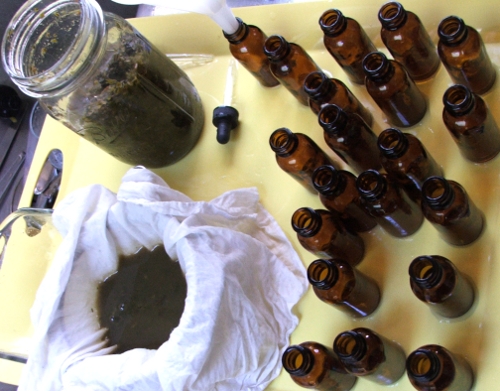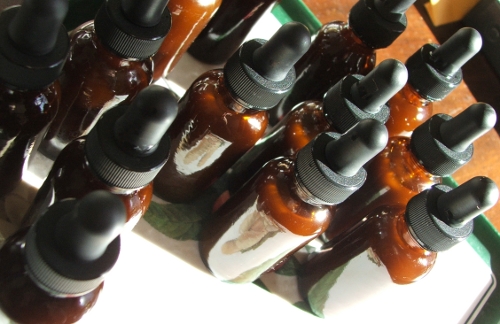Today I pressed the dandelion (Taraxacum officinale) tincture that I started on 14 October (roots and leaves). It has been sitting in my herbal medicine closet (dark, cool and accessible) for over three weeks (14 days is the minimum). I shook it twice daily. It has become a saying in our household: “Mama’s shaking her tincture!”
This was the first time I pressed a tincture and good practice. I now have an idea of how much comes out of a quart jar (15 1 ounce bottles) and I know I need to get hold of a high glass pitcher with a good spout – one that won’t have the sieve sit in the liquid and won’t spill the tincture all over during pouring. I didn’t have muslin for sieving, but the cotton handkerchief did the job quite well.
The tincture is a murky, swamp-green-light-brown. There’s a lot of residue in it, which stresses the need to shake that tincture each time you use it. It has a particular sweet smell underneath the whiff of alcohol (80 proof), a smell mostly in the tip of the nose (how’s that for observation!). It tastes only a tiny bit bitter, but mostly that sweet smell translates to the tongue. It actually doesn’t taste that bad – not like lobelia tincture, for instance, thank goodness.
The following is what I’ve gleaned from several herbalist sources:
Dandelion (Taraxacum officinale)
Cold, bitter and sweet. Affects the liver, bladder, stomach, spleen, and skin. As a bitter, both leaves and roots stimulate appetite and digestion. They are diuretic, so they are used to treat urinary tract problems, and unlike other diuretics, replenish potassium. Dandelion stimulates bile production (in the gall bladder), so it fights gall stones as well as the liver’s lipid (fat) metabolism, fighting jaundice and cirrhosis. The choline in the roots stimulate the mucous membranes of the large intestine to a mild laxative effect. Roots are also good against rheumatism and arthritis. As a blood-purifier and blood vessel cleanser and strengthener, it is good for eczema. It is rich in calcium (especially the root) and will recalcify bones. Externally it can be used to treat fungal and yeast infections. When applied to warts, the latex (the bitter “milk”) will – they say – cure them.
{DISCLAIMER} This information is intended for educational purposes only and has not been evaluated by the FDA. It is not intended to prevent, diagnose, treat, or cure any disease.
And after that disclaimer I must add that it feels good – empowering – to make my own remedies, in my kitchen, from the dandelions I grew and harvested. Still, hopefully I won’t get so many and so much of the above ailments so as to need all 15 ounces of tincture!


I just learned that lobelia (lobelia inflata) is also called Puke Weed!
I am new to this – received Echinacea tincture from my sister and I’ve had it brewing in a dark closet for 6 weeks. I feel a cold coming on so I opened it today. I forgot how she said to use it so I pulled out my measuring spoon and took a little. Tasted like I did a shot. Also, I hadn’t strained it so I had a few leaves.
I read today that you must shake it daily but I did not shake it at all. Do you think it is still useful? Can I use a cotton tee shirt to strain it? Thank you!
Hi SouthFLWife,
I would have no idea, really. I’m just a beginner myself. Possibly it would have less potency, because the solvent (alcohol) couldn’t get to all the herb material and draw out the goodies.
I’ll ask on my herbal info site and get back to you!
Feel better!
Thank you brooklinemama!